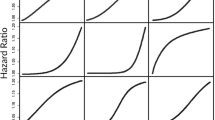Abstract
This paper presents a general framework for constructing a predictive distribution of the exposure to an environmental hazard sustained by a randomly selected member of a designated population. The individual’s exposure is assumed to arise from random movement through the environment, resulting in a distribution of exposure that can be used for environmental risk analysis. A specialization of the general framework is that of predicting human exposure to air pollution that can be used to develop models for such things as exposure to particulate matter; practical aspects of their construction are considered. These models can help answer questions such as what fraction of the population sustained ‘high’ levels of exposure for say 5 days in a row. The immediate implementation of the above framework takes the form of a computing platform referred to as pCNEM. This provides a facility for simulating exposures to airborne pollutants and is described in detail elsewhere. This paper considers some theoretical aspects underpinning probabilistic exposure models of this type, with the ideas illustrated in developing a model for predicting human exposure to PM 10.
Similar content being viewed by others
References
Berhane K, Gauderman WJ, Stram DO and Thomas DC (2004). Statistical issues in studies of the long-term effects of air pollution: the southern California children’s health study (with discussion). Statist Sci 19: 414–449
Burke JM, Zufall MJ and Ökaynak H (2001). A population exposure model for particulate matter: case study results for PM2.5 in Philadelphia, PA. J Expo Anal Environ Epidemiol 11: 470–489
Brown PJ, Le ND and Zidek JV (1994). Multivariate spatial interpolation and exposure to air pollutants. Can J Statist 22: 489–509
Caldor CA, Holloman CH, Bortnick SM, Strauss WJ, Morara M (2003) Relating ambient particulate matter concentration levels to mortality using an exposure simulator. Preprint No. 725. Dept Statist, Ohio State University
Diggle PJ, Tawn JA and Moyeed RA (1998). Model-based geostatistics (with discussion). Appl Statist 47: 299–350
Law PL, Lioy PJ, Zelenka MP, Huber AH and McCurdy T (1997). Evaluation of a Probabilistic Exposure model applied to carbon monoxide (pNEM/CO) using Denver personal exposure monitoring data. J Air Waste Manage Assoc 47: 491–500
Le ND, Sun W and Zidek JV (1997). Bayesian multivariate spatial interpolation with data missing-by-design. J Roy Statist Soc Ser B 59: 501–510
MacIntosh DL, Xue J, Ozkaynak H, Spengler JD and Ryan PB (1995). A population-based exposure model for benzene. J Expo Anal Environ Epidemiol 5: 375–403
McBride S, Williams R, Zidek JV (2004) Assessing a computer model for predicting human exposure to PM 2.5. Poster given at the ISEA 2004 mini-symposium: Exposure Modelling for Outdoor and Indoor Air Pollution
Ott W, Thomes J, Mage D and Wallace L (1988). Validation of the simulation of human activity and pollutant exposure (SHAPE) model using paired days from Denver, CO carbon monoxide field study. Atmos Environ 22: 2101–2113
Özkaynak H, Xue J, Spengler J, Wallace L, Pellizzari I and Jenkins P (1996). Personal exposure to airborne particles and metals: results from the particle team study in Riverside, California. J Expo Anal Environ Epidemiol 6: 57–78
Özkaynak H, MacIntosh D, Sue J, Zhou H (1995) Predicted distribution at personal exposures to PM10 is Canada. Contract Report. Environmental Health Center, Health Canada
Ozone (2006) Air quality criteria for ozone and related photochemical oxidants (Final). U.S. Environmental Protection Agency, Washington, DC, EPA/600/R-05/004aF-cF
PM (2003) Air quality criteria for particulate matter (fourth external review draft). U.S. Environmental Protection Agency, Office of Research and Development, National Center For Environmental Assessment, Research Triangle Park Office, Research Triangle Park, NC, EPA/600/P-99/002aD and bD
Robinson JP, Thomas J (1991) Time spent in activities, locations and MEs: a California-national comparison. Environmental Monitoring Systems Laboratory, Las Vegas, Nevada
Shaddick G, Lee D, Zidek JV (2006) Using estimated personal exposures to assess the short-term effects of air pollution on health. University of Bath, Department of Mathematical Sciecnes Technical Report
Shaddick G and Wakefield J (2002). Modelling multiple pollutants and multiple sites. Appl Statist 51: 351–372
Sun W, Le ND, Zidek JV and Burnett R (1998). Assessment of a Bayesian multivariate interpolation approach for health impact studies. Environmetrics 9: 565–586
Zidek JV, Meloche J, Shaddick G, Chatfield C, White R (2003) A computational model for estimating personal exposure to air pollutants with application to London’s PM10 in 1997. TR, 2003-3, Statistical and Applied Mathematical Sciences Institute, RTP, North Carolina
Zidek JV, Meloche J, Le ND, Sun L (2000) Combining statistical and computer models for health risk assessment (exposure analysis). In: Nez-Antn V, Feffeirra E (eds) Statistical Modelling, Proceedings of the 15th International Workshop on Statistical Modelling: New Trends in Statistical Modelling. Universidad del Pais Vasco, Bilbao, pp 95–106
Zidek JV, Shaddick G, White R, Meloche J and Chatfield C (2005). Using a probabilistic model (pCNEM) to estimate personal exposure to air pollution. Environmetrics 16: 481–493
Author information
Authors and Affiliations
Corresponding author
Rights and permissions
About this article
Cite this article
Zidek, J.V., Shaddick, G., Meloche, J. et al. A framework for predicting personal exposures to environmental hazards. Environ Ecol Stat 14, 411–431 (2007). https://doi.org/10.1007/s10651-007-0028-x
Received:
Revised:
Published:
Issue Date:
DOI: https://doi.org/10.1007/s10651-007-0028-x




